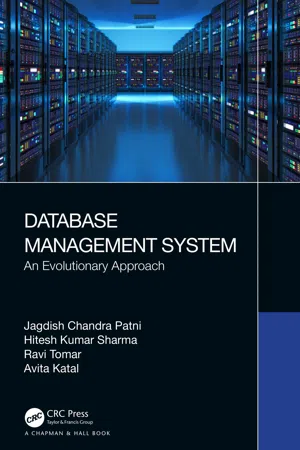
Database Management System
An Evolutionary Approach
- 229 pages
- English
- ePUB (mobile friendly)
- Available on iOS & Android
Database Management System
An Evolutionary Approach
About this book
A database management system (DBMS) is a collection of programs that enable users to create and maintain a database; it also consists of a collection of interrelated data and a set of programs to access that data. Hence, a DBMS is a general-purpose software system that facilitates the processes of defining, constructing, and manipulating databases for various applications.
The primary goal of a DBMS is to provide an environment that is both convenient and efficient to use in retrieving and storing database information. It is an interface between the user of application programs, on the one hand, and the database, on the other.
The objective of Database Management System: An Evolutionary Approach, is to enable the learner to
- grasp a basic understanding of a DBMS, its need, and its terminologies
- discern the difference between the traditional file-based systems and a DBMS
- code while learning to grasp theory in a practical way
- study provided examples and case studies for better comprehension
This book is intended to give under- and postgraduate students a fundamental background in DBMSs. The book follows an evolutionary learning approach that emphasizes the basic concepts and builds a strong foundation to learn more advanced topics including normalizations, normal forms, PL/SQL, transactions, concurrency control, etc.
This book also gives detailed knowledge with a focus on entity-relationship (ER) diagrams and their reductions into tables, with sufficient SQL codes for a more practical understanding.
Frequently asked questions
- Essential is ideal for learners and professionals who enjoy exploring a wide range of subjects. Access the Essential Library with 800,000+ trusted titles and best-sellers across business, personal growth, and the humanities. Includes unlimited reading time and Standard Read Aloud voice.
- Complete: Perfect for advanced learners and researchers needing full, unrestricted access. Unlock 1.4M+ books across hundreds of subjects, including academic and specialized titles. The Complete Plan also includes advanced features like Premium Read Aloud and Research Assistant.
Please note we cannot support devices running on iOS 13 and Android 7 or earlier. Learn more about using the app.
Information
CHAPTER 1 Database Basics
1.1 Introduction and History of Databases
- Primary key (CALC key),
- Moving relationships from one record to another (sets), and
- Scanning the records in sequential order.

1.2 Data and Information
1.2.1 Data
- Shared: Since the data in a database will be used to derive some information for the users, it should be shareable among users as well as applications.
- Persistence: The data in the database resides permanently meaning that even if the process that generated the data or used it ends, the data still exists in the storage beyond the scope of the process creating or using it.
- Integrity: Data stored in a database should be correct with respect to the real world.
- Security: Data stored in a database should not be accessed by unauthorized users.
- Consistency: The values stored in a database corresponding to the real world should also be consistent to the relation of those values.
- Nonredundancy: No two data items should represent the same world entity.
- Independence: The data representation at internal, conceptual, or external level should be independent of each other. Change in one level should not affect the other.
1.2.2 Information

- Accuracy: Accuracy of information refers to the veracity of it. It means there should be no manipulated or distorted information. It should clearly convey the meaning of the data it is based on.
- Timeliness: The information must reach the recipient within the needed time frame. The information may be of no use if it arrives late.
- Relevancy: Relevancy of the information means that the information which may be relevant for one user may not be relevant for another even though it might have been accurate as well as timely. For example: A person who wants to know the configuration of the computer model may get the answer as “The price for the model is Rs 40,000”. Though the information is correct and timely, it is of no use.
1.3 Database
1.4 Need for a Database
Table of contents
- Cover
- Half Title
- Title Page
- Copyright Page
- Table of Contents
- Preface
- Authors
- Chapter 1 ◾ Database Basics
- Chapter 2 ◾ Data Models and Architecture of a DBMS
- Chapter 3 ◾ Relational Database Management System
- Chapter 4 ◾ Entity-Relationship Model
- Chapter 5 ◾ Normalization
- Chapter 6 ◾ Managing Data Using Structured Query Language
- Chapter 7 ◾ Introduction to PL/SQL
- Chapter 8 ◾ Transaction Management in a Database
- Index